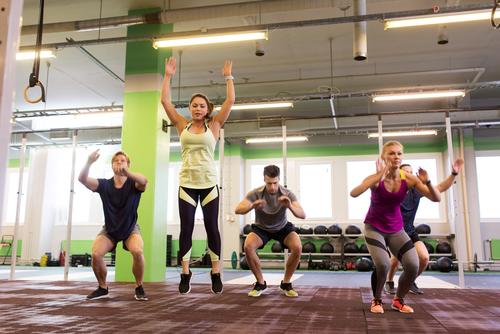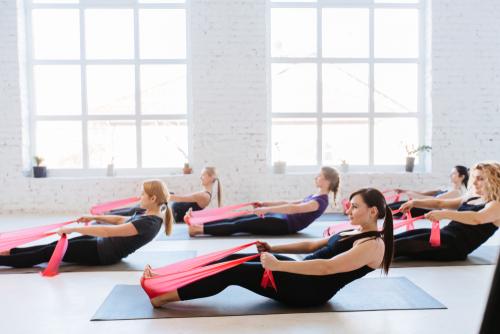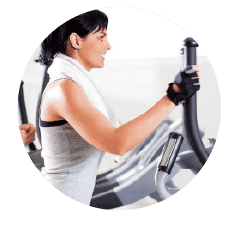How High and Low-Intensity Workouts Can Help you Reach your Fitness Goals
Fitness fads may come and go, but certain regimens stand the test of time for a reason – because they are effective.
One such form of exercise is interval training, which can help you improve your physical fitness levels, increase your cardiovascular health, and help with managing your glucose metabolism. There are two types of well-known interval training, and are used for different purposes.
High Intensity Interval Training, also known as HIIT, involves pushing your body to the limits for short periods of time, followed by a period of rest. Examples of HIIT include running on a treadmill at full speed for a minute, then reducing your speed to a comfortable pace for one to two minutes, and spending the duration of your workout alternating between the two. Experimenting with speeds, inclines and time is also a great way to change up this type of workout to keep things interesting. Other formats of HIIT can include working with bodyweight exercises as well.
“Technically, HIIT can be for many different people and levels. Walkers can walk and jog to raise intensity, and joggers can jog and sprint to raise intensity, so I feel like it is open to almost anyone at any fitness level,” said Phil Dozois, who is a Certified Personal Trainer and Performance Enhancement Specialist and owner of Breakthru Fitness located in Pasadena, California.
Another form of interval training is called Tabata training, which is a type of HIIT. Tabata involves doing various exercises, each lasting four minutes in duration. The structure of Tabata includes pushing yourself to your limit for 20 seconds, followed by 10 seconds of rest, for eight rounds. There is no set program or order of the exercises, and you are free to customize as you see fit. The exercises you can choose from include bodyweight squats, burpees, mountain climbers, push-ups, scissor kicks, planks, plank step-ups, Russian twists, lunges, lateral slides, and more. Integrating the use of equipment like kettlebells and weights to make the workouts more challenging is also allowed.
The difference between HIIT and Tabata is that Tabata involves the eight rounds of four-minute mini workouts. It is simply a type of HIIT named after Izumi Tabata, who was a researcher that discovered the benefits of Tabata in 1996. He found that athletes were able to increase their metabolism and anaerobic capacity (the amount of energy that is produced as a result of these quick-fire bouts of high intensity effort) as a result of doing Tabata workouts five days per week for six weeks total. In his study, he compared this group of exercisers to a group who engaged in less intense workouts, but for a longer duration (Tabata et al., 1996).
Who Can Benefit from Interval Training?
Interval training is great because it is accessible to a wide population of exercisers, it doesn’t require a lot of equipment (and can actually be done without any equipment), and it is time efficient for those who don’t have a lot of time to devote to their workouts. This does not mean interval training regimens are less effective – in fact, exercisers who engage in HIIT burn a lot of calories over a short period of time, and therein lies the appeal.
Interval training is an efficient form of cardio, and people engaging in this type of workout can feel the benefits more quickly. Research backs up these claims. As part of their study, the researchers recruited 16 healthy males to take part in their experiment. Half were randomized to a low-volume sprint interval training, and the other half were randomized to the high-volume endurance training group. The men’s exercise performance, muscle oxygen capacity, and other factors were assessed. When interval training is directly compared to endurance training, researchers found that brief, more intense bouts of exercise resulted in greater muscle oxidative capacity and exercise performance (Gibala et al., 2006).
Benefits of HIIT
Engaging in HIIT workouts can help strengthen your heart, burn more calories, increase your energy levels, and release feel-good endorphins during the process. Because HIIT is efficient, you are able to burn more calories by pushing your body to the limit as opposed to maintaining a steady state of walking or jogging on the treadmill.
Typical HIIT sessions can last from 10 to 30 minutes, and involve short bursts of intense exercise alternated with low-intensity recovery periods (Tinsley, 2017). This structure can be useful for people whose schedules are limited and have a hard time integrating workouts into their routine.
HIIT can burn a significant amount of calories in a smaller time frame. In a study comparing the number of calories burned during 30 minutes of HIIT, weight training, running, or biking, researchers found that participants engaging in HIIT improved their aerobic activity, exercise tolerance and disease marker risks after only a few weeks. The benefits were not simply limited to those participants who are already considered relatively healthy, but also extended to those with cardiometabolic disorders (Gillen & Gibala, 2014). Cardiometabolic disorders are characterized by dysfunctions like insulin resistance, compromised glucose tolerance, and hypertension (Saljoughian, 2017).
“One of the major benefits of engaging in HIIT is the way in which it keeps the body off balance. Engaging in lower level activities over long distances actually make the body more efficient and clients burn less calories over time. With HIIT, clients can get workouts done in less time and actually burn as much or more calories, not including Excess Post-Exercise Oxygen Consumption (EPOC) effects,” said Dozois.
EPOC refers to a person’s increased rate of oxygen intake after he or she engages in vigorous activity. Circuit training leads to greater EPOC, and HIIT is the most effective way to encourage the EPOC effect (McCall, 2014).
Balancing Out the Intensity
When you are consistently pushing yourself to the limit physically, you will also want to ensure you’re taking breaks and engaging in rest and recovery as appropriate.
Low Intensity Steady State Cardio (LISS), is a cardio or aerobic activity that is performed at a low intensity, but for a long period of time ranging anywhere from 30 to 60 minutes in duration. The purpose of LISS is to aid in active rest and recovery, like when you want to take a day off from the higher-intensity workouts described above. Doing this type of exercise regularly is crucial and can help balance out the times when you are engaging in more vigorous and intense activities.
Benefits of LISS
LISS involves maintaining a steady state during exercise for a set period of time. It is not meant to be rigorous and helps exercisers recuperate after HIIT. Walking, jogging, swimming and cycling are all examples of activities that qualify.
At the gym, LISS workouts can be performed on the treadmill, stationary bike, elliptical, rowing machine or stair-climbing machines. To ensure you are maintaining a truly steady state, considering using the built-in monitors or a digital fitness device like a Fitbit or Apple watch to monitor your activity levels (Ramzi, 2017).
The benefits of LISS include increased motivation to lose weight, which is sustained over time. Pushing your body to the limits constantly can cause some exercisers to lose motivation and they may find it difficult to stick with a routine over a long period of time. Over time, LISS promotes greater stress reduction and increased cardiovascular conditioning.
“I have a Pilates studio, so most of the work I do with my clients is low intensity in nature. We do jumpboard, which is more aerobic and cardiovascular in nature. I do Tabata with more advanced clients. With anyone I am coaching, I definitely incorporate some type of Pilates, yoga, and stretching, which is very important,” said Miranda McGovern, owner of Studio M Pilates & Fitness located in Chico, California.
LISS is also a great way for individuals who are easing back into a workout routine or want to engage in exercise after a long period of inactivity. Due to the low-impact nature of LISS, engaging in this type of workout means you aren’t straining your muscles, joints, tendons and ligaments. Furthermore, you can continue this type of exercise the next day. However, exercisers shouldn’t fall into the trap of engaging in only LISS, for a variety of reasons as well as for health reasons.
“Core training and stability overall is important, since cardio can only get you so far. After age 30, everyone starts to lose lean muscle mass as part of the aging process, so incorporate some type of resistance training as well,” McGovern said.
Avoiding Injury
As with any type of exercise, there is always a risk for injury. For exercisers engaging in HIIT and Tabata, injuries could include pressure on the joints and straining the muscles due to over movement or not engaging in proper warmup. Warming up and stretching prior to engaging in HIIT and Tabata is very beneficial. If you are working out on a treadmill, including a cool-down is necessary to reduce risk of injury to joints.
“The best way to avoid injuries is good mobility and a dynamic warm-up for 10 minutes before your workout, and then a cool down with static stretching for at least five minutes. The key is to rest the next day or two after,” Dozois explained.
Balancing bursts of heart-pumping activity with periods of active rest and recovery is essential, that is why HIIT and LISS work so well together. For older adults, the risk of injury can include exasperating the knees and wrists, or other sensitive areas.
“It’s important for people to understand that as they age, their recovery time goes up. You’re naturally going to need more rest and recovery as you age,” McGovern said. “The potential for injury is also greater for older adults doing higher intensity workouts because they need those longer recovery periods. If you are an older adult who is just getting started, I recommend working yourself up to doing HIIT training.”
Incorporating HIIT & LISS into your Fitness Routine
For those who are just starting out with interval training, the use of technology can help you ease into HIITs. There are many smartphone apps focusing on full-body workouts in 20 minutes or less, and some are affiliated with digital fitness tracking devices you may already own and brands you already support, such as the Fitbit or Nike. For a ranked list, click here.
For those who are already avid exercisers but want to incorporate more HIIT and LISS into their routines, consider adding a high-intensity day, or building a program of circuit training into your existing regimen. Including an active day of rest will help your body and muscles recover.
So, how often should you be incorporating HIIT into your routine?
“If the workouts are really intense, twice a week is plenty,” Dozois said. “I would say if you are really fit and are consistent with your recovery, maybe three times a week, but two HIIT sessions works wonders. I believe anyone can do HIIT.”
McGovern also recommends that people consider their fitness goals when engaging in higher intensity training, but agrees that two to three times per week is a good number.
“The rest of the time [when you’re not doing HIIT training], you should be building your base by working in a lower intensity but longer duration type of workout versus doing interval type training. Another thing to be mindful of is that always doing HIIT causes your body to reach a plateau and you won’t continue to see results over time,” she added.
Measuring Effectiveness
So how do you know if your HIIT training is working for you? Fortunately there are tools and tests to help you assess your progress.
“You can use the heart rate max test or the zone program to see if you are increasing their VO2,” McGovern recommended.
The VO2 rate refers to a quantitative number that represents your body’s ability to consume oxygen. This is important because it can signify how well your body can take in oxygen then subsequently deliver it to your muscles.
“A lot of the treadmills have baseline tests on them, which is useful because then you will know your max heart rate and can see if things change as you engage in your HIIT program. Targets vary, though, based on your gender and age, so that is something to keep in mind,” McGovern added.
Conclusion
The benefits of engaging in high-intensity workouts, balanced by lower-intensity workouts, can be the key to maintaining optimal health and changing up your routine. Benefits of HIIT can include increased cardiovascular endurance and weight loss, whereas the benefits of LISS include less risk of injury and a period of active rest and recovery.
“Cross training is key. You need to run, cycle, yoga – having different modalities is important. Even if you’re not an athlete, you can vary it by hiking, walking and running,” McGovern said.
In addition, making sure your exercise regimen doesn’t get boring is also an important factor in ensuring that you stay motivated and don’t get bored. Alternating between these two types of workouts—or even just incorporating them into your routine on a regular basis—can help you achieve your fitness goals.
By Nicki Karimipour, PhD

Dr. Nicki Karimipour is a communications expert and experienced researcher. She obtained her master’s degree and Ph.D. in Health Communications from the University of Florida. She obtained her bachelor’s degrees from Florida State University.
Dr. Karimipour has previous experience in writing and editing for both print and online publications, and in teaching journalism, health writing, and public relations at the undergraduate and graduate level.
Her research-related experience ranges from collaborating with medical researchers and consulting on clinical trials, to clinical research program management. Her own research focuses on a variety of health topics, such as effects of social media use on female body image, football and concussions, and e-cigarette use among youth. Her research has been published in the Journal of Clinical and Translational Research, the Journal of Behavioral Health Services & Research, and the Journal of Sports Media.
She is based in Los Angeles, California and currently works at the University of Southern California in clinical trial operations. Follow her on Twitter: @NickiKPhD
References
Gibala, M.J., Little, J.P., Van Essen, M., Wilkin, G.P., Burgomaster, K.A., Safdar, A., Raha, S., & Tarnopolsky, M.A. (2006). Short‐term sprint interval versus traditional endurance training: similar initial adaptations in human skeletal muscle and exercise performance. The Journal of Physiology, 575(3), 901-911. https://physoc.onlinelibrary.wiley.com/doi/full/10.1113/jphysiol.2006.112094
Gillen, J.B, & Gibala, M.J. (2014). Is high-intensity interval training a time-efficient exercise strategy to improve health and fitness? Applied Physiology, Nutrition, and Metabolism, 575(3), 901-911. https://physoc.onlinelibrary.wiley.com/doi/full/10.1113/jphysiol.2006.112094
McCall, P. (2014). 7 Things to know about excess post-exercise oxygen consumption (EPOC). Retrieved from https://www.acefitness.org/education-and-resources/professional/expert-articles/5008/7-things-to-know-about-excess-post-exercise-oxygen-consumption-epoc
Tabata, I., Nishimura, K., Kouzaki, M., Hirai, Y., Ogita, F., Miyachi, M., Yamamoto, K. (1996). Effects of moderate-intensity endurance and high-intensity intermittent training on anaerobic capacity and VO2max. Medicine & Science in Sports & Exercise, 28(10), 1327-30. https://www.ncbi.nlm.nih.gov/pubmed/8897392
Tinsley, G. (2017). 7 benefits of high-intensity interval training (HIIT). Healthline. Retrieved from https://www.healthline.com/nutrition/benefits-of-hiit
Ramzi, L. (2017). Why taking it easy at the gym may be the best new fat-burning strategy. Vogue. Retrieved from https://www.vogue.com/article/workout-exercise-liss-cardio-low-intensity-fat-burning-weight-loss
Saljoughian, M. (2017). Cardiometabolic syndrome: A global health issue. U.S. Pharmacist. Retrieved from https://www.uspharmacist.com/article/cardiometabolic-syndrome-a-global-health-issue





 Compact/Folding
Compact/Folding Front Drive
Front Drive Rear Drive
Rear Drive